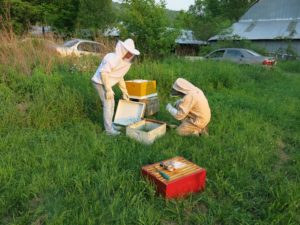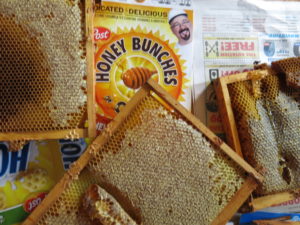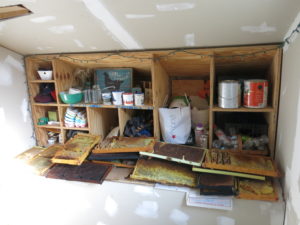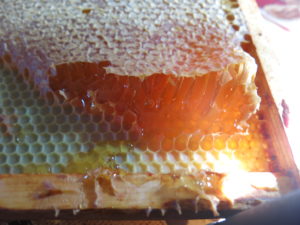
Every year around this time, when the chill returns to the air and the leaves crunch on the ground, beekeepers all around New York start to “winterize” their hives, in other words, tuck them in for winter. The beekeeping calendar is pretty simple in theory. First, in the spring, you open up the hive (or start your new hive) and provide sugar water and pollen patties for food before the flowers start to bloom. In the summer, you watch the hives for activity, add more boxes if the hive is filling up with honey, and dust the frames with powdered sugar to prevent mites. In the fall, you close off the entrance to prevent scavengers like mice and yellowjackets from stealing the honey when other food sources are becoming scarce. Then, near the end of fall, you insulate the hive and let them “hibernate” through the winter. When to harvest the honey? Only when you know they have enough to get them through the winter.
Simple in theory, we say, because we have yet to be very successful. In 2015, we started two hives which were humming through the summer. Then in the fall, we opened one of the hives that had been thriving a week before only to find it destroyed by mice and yellowjackets. Hard Lesson #1: Protect the hive sooner.
The other hive made it and looked very healthy. However, some time amidst the strangely mild weather of winter/spring 2015-2016, the hive lost its queen. Normally a hive will raise up a new queen from one of the eggs (ever heard of royal jelly?) but they need to do it within a certain window. Our bees unfortunately missed that window.
It was time to start over at Square 1.
Spring rolled around this year and we bought two more “nucs” (a small hive of honeybees) from the Southern Tier Beekeeping Association. Even with the drought this summer, the hives thrived with busy busy bees. Casey would check them occasionally and they were filling with honey fast–he had to add more boxes! In August, Casey applied our Hard Lesson #1, blocking off the entrance to the hive to protect from invaders.

A few weeks ago we learned Hard Lesson #2… Casey walked past one of the hives and saw… yellowjackets, flying in and out of it. With a sinking heart, he checked the other hive and saw the same thing, but not quite as many. He rushed inside to research what could have happened and found that some beekeepers recommend closing off the entrance to less than 1″ as opposed to the 3-5″ we had seen in most beekeeping books. Perhaps the drought made the scavengers worse this year?
This week Casey donned his bee suit to check out the hives. There is good news and bad news here. Bad news first, of course! Yes, the hives were dead. But we had a silver lining this year, or rather a golden lining: we have HONEY.

About 20 frames of it, which you can see stacked around our house…


This is very good news. We should be able to harvest enough honey to make up for the cost of buying the bees each spring, making it worth it to try again next year (before this encouraging development we nearly gave up!) The third time should be the charm, or so we hope!

The most exciting thing for us is that we can have some our OWN honey to put in the farm store (in addition to honey from other local farms). Thank the Lord for this reward. It is a sweet victory.
